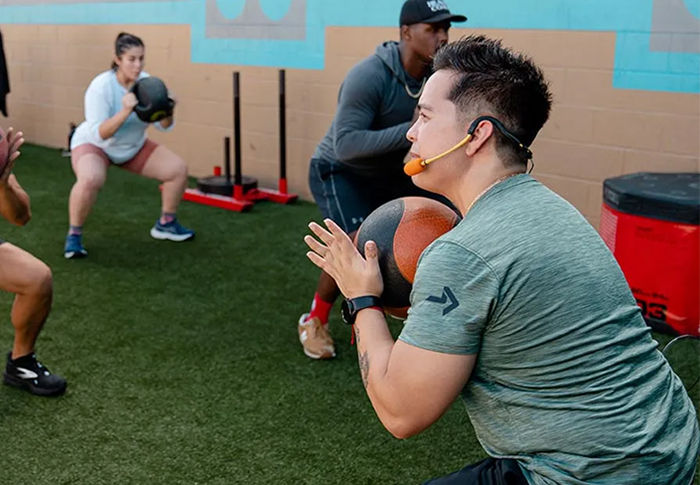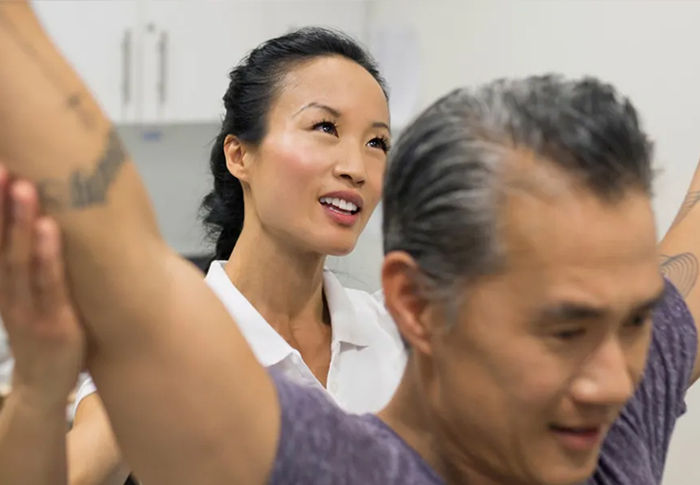
Two Small Shifts, Big Blood Sugar Benefits

For clients navigating two increasingly common health concerns—prediabetes or early-onset type 2 diabetes—simple, repeatable habits are often more effective than complex protocols when it comes to long-term behavior change. Four recent studies highlighted two effective habits that you can support your clients in working toward: (1) eating dinner a bit earlier and (2) taking a brisk walk right after eating to reduce postprandial glucose exposure. Together these strategies target glycemic variability and next-morning fasting glucose, which have been linked to increased cardiometabolic risk.
Dinner Timing Matters More Than Most People Think
Across both observational and experimental studies, eating later in the day has been linked with poorer glucose tolerance, independent of weight, body fat, calorie intake or general diet quality. In a brief communication from the New York Time-Restricted EATing (NY-TREAT) project, adults with overweight or obesity and either prediabetes or diet/metformin-controlled type 2 diabetes were classified as “later eaters” if they consumed 45% or more of daily calories after 5 p.m. Later eaters showed higher glucose levels during a two-hour oral glucose tolerance test than earlier eaters. The authors concluded that later eaters “had poorer glucose tolerance, independent of body weight, fat mass, daily energy intake and diet composition.”
Physiological evidence from the same program helps to explain why the timing of that last meal shapes the next morning’s numbers. In a controlled 24-hour protocol using continuous glucose monitoring (CGM), investigators focused on the “last evening meal” and its subsequent effects on overnight glucose and next-day fasting glucose in adults with prediabetes or diet-controlled type 2 diabetes. Glucose responses during the three-hour window after the last meal were strongly correlated with the following morning’s fasting glucose. Overnight glucose tracked fasting glucose as well, and part of that relationship was explained by the carbohydrate content of the late meal and by individual insulin sensitivity. In short, the evening post-meal rise sets the stage for next-morning fasting values, and both meal timing and composition influence the effect.
These findings align with a small, randomized crossover trial in healthy adults comparing an early dinner (6 p.m.) with a late dinner (9 p.m.). A simple three-hour shift yielded a significantly lower mean 24-hour glucose the next day when dinner was eaten early. An earlier dinner led the body to burn more fat at breakfast the next day, which is a sign of better overnight metabolic flexibility. As the authors put it, “Eating dinner early [at 6 p.m.] has a positive effect on blood glucose level fluctuation and substrate oxidation compared with eating dinner late [at 9 p.m.].”
Put simply, that final meal of the day doesn’t just end digestion—it sets the stage for overnight glucose patterns and next-morning fasting levels. Collaborating with clients to set goals around moving dinner to an earlier time—even by an hour or two—reduces overlap between the post-meal peak and the overnight period, helping curb next-day fasting glucose and reduce blood-sugar swings.
Common Barriers and Practical Solutions
Evening schedules can be hectic—kids’ activities, commutes, social meals. Rather than “eat at 6 p.m. or bust,” encourage clients to anchor the habit to bedtime and pair it with environment design. Clients can choose to set a “kitchen curfew” alarm three-and-a-half to four hours before lights out to start the wind-down toward an earlier meal. Suggest batch-cooking protein and vegetables on weekends to reduce decision friction at 7 p.m. For social dinners that run late, suggest that clients front-load protein and non-starchy vegetables at the table, eat starchier sides earlier in the day when feasible and take that 10-minute walk immediately afterward—even if it’s up and down the block.
For clients in apartments or unsafe neighborhoods, a marching-in-place “TV walk,” stairwell laps, or a hallway out-and-back circuit can substitute. The key to successfully making this a habit is immediacy and consistency, not scenery.
The Surprising Effectiveness of a 10-Minute After-Dinner Walk
A brisk 10-minute walk right after eating targets the same physiology from the other direction: it blunts the after-meal rise in blood sugar. Although these studies did not specifically examine post-meal walking, they consistently showed that evening after-meal glucose influences overnight patterns and next-morning fasting levels. Therefore, any safe, simple tactic that reliably reduces that rise—particularly after dinner—should be beneficial.
A short, purposeful walk fits the bill. For most clients, 10 minutes is more achievable than a formal workout and can be attached to each meal. Walking right after eating draws glucose into active muscle, which lowers the post-meal spike. The walk’s short length helps with consistency, and going right after dinner aligns with how the body works—lower the evening spike, sleep steadier and wake with a better fasting value.
Finally, it’s worth noting that while most studies focused on individuals with elevated glucose or metabolic dysfunction, this post-meal walking strategy is a good approach for most clients, particularly those who want to prevent blood sugar dysregulation.
Why Glycemic Variability Deserves Your Attention (and Your Clients’)
A 2022 systematic review and meta-analysis that included 75 cohort studies and more than 2 million participants found that greater visit-to-visit swings in HbA1c (a measure of average blood sugar levels over two to three months) or fasting plasma glucose were linked with higher risks of all-cause mortality, cardiovascular disease and kidney disease in people with diabetes. Across outcomes, participants with the highest variability faced 30 to 90% greater risk of mortality, cardiovascular events and kidney complications than those with more stable glucose patterns. The authors concluded that long-term glycemic variability is associated with multiple adverse diabetes-related outcomes and warrants attention in clinical management.
What does that have to do with an earlier dinner or a 10-minute walk after eating? Both behaviors can shrink and shift late-day glucose swings—particularly after dinner—which should, over time, reduce day-to-day volatility and even out blood-sugar swings. Here are some practical ways to help your clients integrate these recommendations into their lifestyles.
1. Eat dinner a little earlier. From a behavior-change standpoint, “earlier” should be realistic and sustainable based on the client’s current routine. Even a shift of 30 to 60 minutes earlier can make a meaningful difference. For someone who routinely eats at 9 p.m., moving to 8 p.m. is a meaningful first step; for a client already at 7:30 p.m., they should consider aiming for 6:30 to 7 p.m. Clients may ask, “How early is early enough?” There’s no single clock time, but a practical rule is to leave at least three hours between the end of dinner and bedtime. For shift workers or those with later sleep schedules, tie the guideline to their usual bedtime rather than the wall clock: “Finish dinner at least three hours before lights out.”
2. Take a brisk, 10-minute walk right after you eat. Because the studies centered on timing and next-day metrics, frame the after-dinner walk as a direct way to shrink the size and duration of the after-dinner spike in blood sugar. Encourage clients to start moving as soon as they get up from the table and to walk with intent and with enough pace to feel slightly breathless but still conversational. Ten minutes is a floor, not a ceiling; if a client prefers 15 to 20 minutes, even better, especially after dinner.
While this specific walking protocol wasn’t tested directly within the four papers, its intended effect—reducing the height and length of the after-dinner spike in blood sugar—aligns with the reported relationships between late-day glucose dynamics and next-morning fasting values, as well as broader links between variability and outcomes. Make that alignment explicit in your coaching: “We’re using this walk to lower the size of the rise in blood sugar that comes after a meal, which matters most at night.” Clients who already walk after dinner could be encouraged to increase the pace or duration slightly for added benefit.
Talking Points to Use With Clients
Motivational interviewing can be used to encourage clients to learn more. Specifically, the Ask, Offer, Ask (AOA) method can be applied within the context of a nonjudgemental and trusting relationship as a way to exchange information as needed based on the client’s personal experience.
Clients don’t need a physiology lecture; they need a clear "why" and a doable "how" that is connected to their values and reasons for wanting to change their behavior. Advice and information can be more easily accepted when it is surrounded by good listening.
In this example, you might first ask, “What do you already know about how meal timing impacts glucose processing?” at an appropriate time during a coaching session. After this initial ask, the client may share what they know and then request more information. This gives you the opportunity to offer one or more of the suggestions below, or you might follow up by asking something like, “Would it be O.K. if I describe a few more ways in which meal timing impacts glucose responses?”
- “Your body handles glucose best earlier in the day.” Research suggests that people who consume more of their calories later in the day tend to process glucose less effectively—even when weight, total calories and diet composition are similar.
- “Tonight’s dinner decides tomorrow morning’s fasting.” In controlled protocols using continuous glucose monitors, the glucose rise after the last evening meal—and the overnight pattern that follows—strongly correlates with next-morning fasting glucose. Eating dinner earlier reduces how much of that rise extends into the nighttime hours.
- “Steadier beats spikier.” Long-term glycemic variability is associated with higher risks of mortality, cardiovascular disease and renal disease in diabetes. Small daily choices that flatten peaks—like dinner timing and a short post-meal walk—can lead to fewer blood sugar swings throughout the day.
After you have offered the related information, you can follow up with another ask, such as “What questions do you have?” “Does that make sense?” or “What would you like to know more about?” Following the AOA method allows the client to share with you what they already know and to remain in control of deciding what they would like to learn more about.
Blood Sugar Management and the Soleus Push-up
Could a micro-movement like heel raises (dubbed the soleus push-up) be a useful tool in helping your clients prevent or manage diabetes? In this video, Sami Mansfield describes the results of this research and how health and exercise professionals can share these findings with their clients. You can find more innovative, science-based strategies to help your clients manage diabetes here, and the original study on the soleus push-up here.
How to Apply This Research as a Health and Exercise Professional
Start by talking to your client about when they usually eat dinner and go to bed. If they are unsure or have an irregular schedule, a quick two-week food and schedule log should help them identify some consistent patterns. If they tend to eat their last meal within three hours of bedtime, consider talking about whether the client typically eats more of their total calories late in the day. From there, pick one clear goal, such as moving dinner a little earlier. Make the shift realistic, such as 60 to 90 minutes sooner, and help them tie it to a cue they already have, like a calendar reminder, the end of a workday meeting or a child’s pickup time. Encourage them to reduce friction by planning simple, earlier-evening meals, prepping ingredients on weekends or using a slow cooker so dinner is ready before it gets late.
Once dinner is set, pair it with a 10-minute walk that starts as soon as they have finished eating (and perhaps even before clean-up begins). Frame it as part of dinner, not a bonus workout. Ask the client to walk with purpose—slightly breathless but still able to talk—and to treat 10 minutes as the minimum. If a neighborhood walk isn’t possible, suggest hallways, stairwells, marching in place or a short loop near home. For shift workers or late schedules, anchor the guidance to sleep: finish dinner at least three hours before lights out, then walk.
To help clients understand the impact of the new habits they are trying to form, encourage them to note how they sleep, how steady their energy feels the next morning, how hungry they are late at night and whether the routine feels easy to maintain. Check in weekly and adjust. If the client takes glucose-lowering medications, especially those with hypoglycemia risk, coordinate with their healthcare provider before changing meal timing or adding post-meal activity.
Expect a bit of trial and error. Some clients will need a slower shift earlier, and others may prefer a slightly longer walk. Your role is to help them problem-solve barriers—busy evenings, family schedules, low motivation—and protect the two anchors: eat a little earlier and walk right after. When those two habits become automatic, clients are more likely to report steadier evenings, better sleep and easier mornings, which reinforces adherence without needing to track numbers.
Conclusion
For clients managing prediabetes or type 2 diabetes, small, strategic changes can have an outsized impact. Encouraging earlier dinners and short post-meal walks offers a simple, sustainable way to improve glycemic control, reduce variability and support long-term health. As a health and exercise professional, your ability to translate science into daily habits is key—remind clients that even modest changes, done consistently, can shift the trajectory of their wellness journey.

More Articles
- Certified™: November 2025
The Anti-Burnout Guide for Health and Exercise Pros
Contributor
- Certified™: November 2025
Spinal Stability in the Real World: When to Brace and When to Breathe
Contributor




 by
by 

